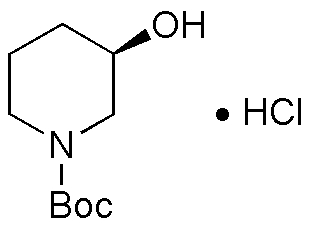(R)-N-(tert-butoxycarbonyl)-3-hydroxypiperidine is widely utilized in research focused on:
- Pharmaceutical Development: This compound is a key intermediate in the synthesis of various pharmaceuticals, particularly in the development of analgesics and anti-inflammatory drugs. Its unique structure allows for modifications that enhance drug efficacy.
- Organic Synthesis: It serves as a versatile building block in organic synthesis, enabling chemists to create complex molecules with specific functional groups. This is particularly beneficial in the fields of medicinal chemistry and materials science.
- Peptide Synthesis: The compound is used in the synthesis of peptides, which are crucial in drug discovery and development. Its protective group can be easily removed, facilitating the formation of peptide bonds.
- Research in Neuroscience: Due to its structural properties, it is being explored for potential applications in neuroscience, particularly in the development of compounds that target neurotransmitter systems.
- Biotechnology: This chemical plays a role in biotechnological applications, such as the development of enzyme inhibitors and other bioactive compounds, which can be used in various therapeutic contexts.
General Information
Properties
Safety and Regulations
Applications
(R)-N-(tert-butoxycarbonyl)-3-hydroxypiperidine is widely utilized in research focused on:
- Pharmaceutical Development: This compound is a key intermediate in the synthesis of various pharmaceuticals, particularly in the development of analgesics and anti-inflammatory drugs. Its unique structure allows for modifications that enhance drug efficacy.
- Organic Synthesis: It serves as a versatile building block in organic synthesis, enabling chemists to create complex molecules with specific functional groups. This is particularly beneficial in the fields of medicinal chemistry and materials science.
- Peptide Synthesis: The compound is used in the synthesis of peptides, which are crucial in drug discovery and development. Its protective group can be easily removed, facilitating the formation of peptide bonds.
- Research in Neuroscience: Due to its structural properties, it is being explored for potential applications in neuroscience, particularly in the development of compounds that target neurotransmitter systems.
- Biotechnology: This chemical plays a role in biotechnological applications, such as the development of enzyme inhibitors and other bioactive compounds, which can be used in various therapeutic contexts.
Documents
Safety Data Sheets (SDS)
The SDS provides comprehensive safety information on handling, storage, and disposal of the product.
Product Specification (PS)
The PS provides a comprehensive breakdown of the product’s properties, including chemical composition, physical state, purity, and storage requirements. It also details acceptable quality ranges and the product's intended applications.
Certificates of Analysis (COA)
Search for Certificates of Analysis (COA) by entering the products Lot Number. Lot and Batch Numbers can be found on a product’s label following the words ‘Lot’ or ‘Batch’.
Numéro de catalogue
Numéro de lot/série
Certificates Of Origin (COO)
This COO confirms the country where the product was manufactured, and also details the materials and components used in it and whether it is derived from natural, synthetic, or other specific sources. This certificate may be required for customs, trade, and regulatory compliance.
Numéro de catalogue
Numéro de lot/série
Safety Data Sheets (SDS)
The SDS provides comprehensive safety information on handling, storage, and disposal of the product.
DownloadProduct Specification (PS)
The PS provides a comprehensive breakdown of the product’s properties, including chemical composition, physical state, purity, and storage requirements. It also details acceptable quality ranges and the product's intended applications.
DownloadCertificates of Analysis (COA)
Search for Certificates of Analysis (COA) by entering the products Lot Number. Lot and Batch Numbers can be found on a product’s label following the words ‘Lot’ or ‘Batch’.
Numéro de catalogue
Numéro de lot/série
Certificates Of Origin (COO)
This COO confirms the country where the product was manufactured, and also details the materials and components used in it and whether it is derived from natural, synthetic, or other specific sources. This certificate may be required for customs, trade, and regulatory compliance.


